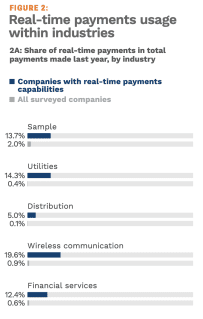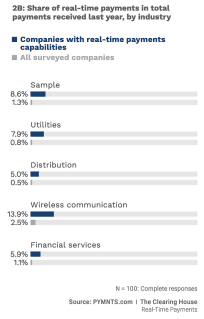Data: Real-Time Payments Usage Rising Among Mid-Market Companies

Fifteen percent of companies from four industries with annual revenue between $50 million and $1 billion currently use real-time payments to make or receive payments, according to “Real-Time Payments: The Fast Track To The Future Of Corporate Payments,” a PYMNTS and The Clearing House collaboration based on a survey of 100 executives.
Get the report: Real-Time Payments
Among the surveyed companies that use real-time payments, 14% of their payments are made and 9% are received using real-time payments. However, the percentages vary widely by industry.
Executives at companies that use real-time payments in three of these industries reported that real-time payments accounted for a double-digit share of the total payments they made last year, with those in wireless communication reporting 20%, utilities reporting 14% and financial services reporting 12%.
In the distribution industry, only 5% of their payments were made using real-time payments.
Among all surveyed companies — including both those that currently use real-time payments and those that do not — none of the industries reported that real-time payments accounted for more than 1% of the total payments they made last year.

When it comes to payments received, companies that use real-time payments in only one industry reported that real-time payments accounted for a double-digit share of the total payments they received last year, with wireless communication reporting 14%.
The share of payments that were received using real-time payments was 8% in utilities, 6% in financial services and 5% in distribution.
Among all surveyed companies — including both those that currently use real-time payments and those that do not — those in the wireless communications industry said real-time payments accounted for about 3% of the total payments they received last year. In the other three industries, the percentage was no more than 1%.

Although the overall proportion of payments made in real time is still somewhat limited, companies that understand that the myriad benefits outweigh the costs and quickly adopt this payment method stand to reap the benefits this payment offers.
